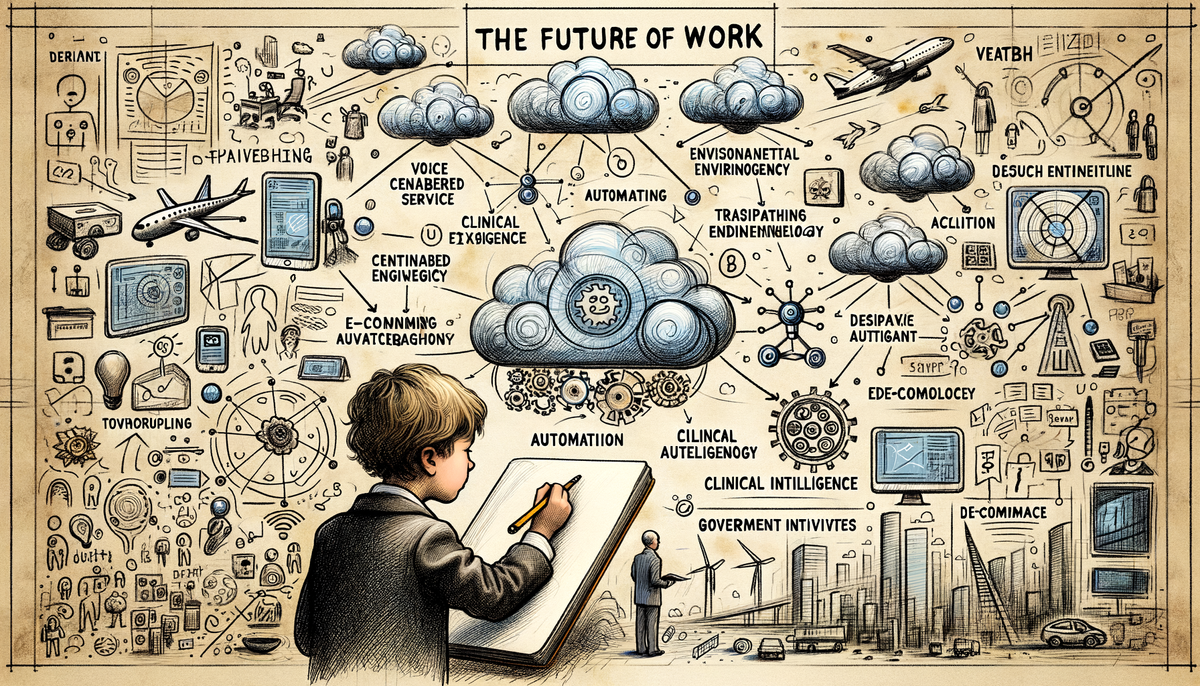Innovations in AI and Environmental Solutions

In this comprehensive exploration of the latest breakthroughs and innovations in artificial intelligence, we delve into transformational developments from voice-enabled customer service and sustainable environmental engineering to clinical intelligence, e-commerce automation, dedicated server technology, and travel-enhancing AI updates, all while highlighting government initiatives that usher in a new era of public service. This article offers an in-depth analysis of how AI is permeating diverse sectors, transforming operations, and redefining future technological landscapes.
Voice-Enabled AI: Redefining Customer Engagement
Artificial intelligence is rapidly reshaping the way companies interact with customers, and a striking example is provided by Nextech3D.ai’s recent unveiling of its voice-enabled AI-powered customer service chat agent. Powered by Eleven Labs’ advanced voice synthesis technology, this innovative solution goes beyond simple query responses. It supports automated appointment scheduling, lead generation, and dynamic knowledge base management, while ensuring natural interaction that mimics human nuance.
Industry leaders have noted that incorporating a live agent handoff in this system is a game changer. It offers customers the reassurance of human assistance when needed, ensuring a safety net in the case of more complex issues. As CEO Evan Gappelberg mentioned, this initiative represents a fusion of automation with human sensitivity and reflects the underlying trend of integrating AI deeply into customer service frameworks.
This breakthrough emphasizes a broader narrative across various industries: leveraging AI to streamline operations while enhancing user experience. As detailed on StockTitan news, such innovations are not only technological marvels but also strategic moves aimed at achieving operational efficiency and deeper customer engagement.
"AI is likely to be either the best or worst thing to happen to humanity." – Stephen Hawking, Brief Answers to the Big Questions
The integration of voice technology into service aims to shorten response times, reduce staffing pressures, and offer a solution that’s both scalable and adaptable to various market needs. It’s interesting to note how one can draw parallels with historical automation revolutions, where technology quickly became an indispensable ally in business.
Environmental Engineering and AI: Charting a Sustainable Future
Parallel to advancements in customer service, AI is being widely adopted in environmental engineering and sustainability initiatives. At a recent technical conference in Vancouver hosted by GHD, the conversation was dominated by how AI solutions are revolutionizing traditional engineering practices. With a focus on practical applications—ranging from drone-enabled façade inspections to predictive modeling for urban planning—AI is actively contributing to sustainability goals.
Dr. Kerry Neil of GHD expressed his enthusiasm about transforming classical engineering practices with modern AI applications. The technology not only supports asset management but also enhances monitoring for air quality and water management. Such real-time analytics and precision forecasting underscore the role of AI in ensuring environmental sustainability.
For instance, AI is now pivotal in sustainable watershed management. The ability to analyze voluminous datasets and predict environmental behavior gives city planners a robust tool to manage urban expansion while keeping an eye on ecological impacts. These innovations ensure that while communities grow, the environmental footprint is minimized.
In one of our previous AI.Biz posts, we highlighted a similar approach where technological strategies are implemented to balance development with environmental responsibilities. GHD’s initiative is a quintessential example of a company integrating AI with real-world impact.
Dedicated Servers: The Unsung Hero of High-Performance Computing
The demand for robust, secure, and high-performing computing power continues to be a critical factor for many organizations. With cloud computing dominating headlines, dedicated servers have maintained their niche appeal—especially in sectors where performance and regulatory compliance are paramount. As detailed in an enlightening piece on dedicated servers, these systems offer exclusive access to resources that enhance stability and performance.
The key benefits of dedicated servers are not limited to customization and security; they also provide predictable cost control by eliminating the issues related to the fluctuating demands of shared resources. Industries with sensitive data requirements, such as finance, healthcare, and legal, particularly appreciate the isolated environment that dedicated hosting offers.
The performance that dedicated servers deliver is essential when handling compute-intensive processes like big data analytics, machine learning model training, and augmented reality applications. While cloud-based services are trending due to their flexibility, the fine-tuned environment of a dedicated server continues to be a top choice for many enterprises where reliability and speed are critical.
In our previous discussion on dedicated infrastructure on AI.Biz, we noted how individually tailored server solutions can create competitive advantages in tech-driven operations. This realm of technology, though sometimes overlooked, forms the backbone of many large-scale AI deployments, helping to manage complex computational tasks quickly and safely.
AI in Healthcare: Enhancing Clinical Intelligence
Healthcare has emerged as one of the most promising applications for AI, where the stakes are high and the potential benefits enormous. A groundbreaking collaboration between the New Jersey Innovation Institute (NJII) and Cognome is setting new standards in clinical intelligence. This alliance leverages advanced AI models to improve patient care outcomes while reducing the burden on healthcare providers.
The collaboration capitalizes on technologies such as ExplainerAI, which is developed adhering to the stringent NIH AI Governance framework to ensure transparency and minimize biases. This adherence is especially critical in healthcare, where ethical considerations must guide any technology innovation. For instance, the integration of AI with electronic health records (EHRs) offers real-time decision support for physicians, particularly in critical situations like managing sepsis or streamlining charting procedures with tools such as AutoChart AI.
In a sector marked by continuous challenges in efficiency and patient care, such innovations are providing tangible benefits. Reducing manual charting by more than 90% not only cuts down on administrative overhead but also allows healthcare providers to focus more on patient interaction. It is truly a convergence of technology and compassion, reflecting how digital advances can complement traditional healthcare practices.
For further insights into AI’s transformative potential in healthcare, I encourage you to see our further discussion on clinical intelligence in our similar series on AI.Biz.
AI-Driven Automation in E-Commerce: Reshaping Retail Operations
E-commerce is another sector that has experienced radical enhancement through AI. Recently, a notable collaboration between CIRRO Fulfillment and Pipe17 has set off a wave of innovation in the retail space. By integrating AI-driven automation into inventory management, order processing, and real-time tracking, the e-commerce industry is undergoing a fundamental transformation. This new approach ensures that online businesses can not only meet customer expectations but also scale operations with unprecedented agility.
Gone are the days when manual updates dictated the pace of order fulfillment. With AI-led automation, operations can incorporate real-time data feeds that reduce errors and optimize logistics seamlessly. This development has practical implications for reducing operational costs, enabling companies to reallocate resources toward customer service and innovation. In a market where every second counts, AI’s ability to track inventory in real time is key to staying competitive.
While the financial aspects of these transformations are still being evaluated, market responses, including a mix of bullish and cautious stances among key industry players, highlight the disruptive potential of AI in this sector. The strategic importance of automation in retail is further underscored by its ability to bridge the gap between customer expectations and the logistics of scaling operations.
As you explore our detailed case studies on AI-driven retail strategies on AI.Biz, you'll discover that this shift is more than a trend; it's a structural change in the digital retail infrastructure that is here to stay.
Travel and AI: Navigating the Future of Adventure
The travel industry, too, is benefiting from the integration of smart AI updates. Google’s latest suite of AI-powered travel tools is designed to enhance the customer journey from planning to exploration. With features like tailored itineraries, interactive maps, and innovative price-tracking mechanisms on Google Flights, travelers are set to enjoy personalized and hassle-free trip planning—especially important in a season marked by high travel volumes.
The incorporation of AI Overviews into travel apps illustrates how digital tools can transform a conventional vacation into a data-driven adventure. Whether it’s pinpointing iconic attractions through Google Lens or staying updated with real-time trends on popular destinations like Curacao, Osaka, and Tokyo, these tools empower individuals to plan trips that are both efficient and immersive.
From a broader perspective, this initiative signals a melding of hospitality with advanced technology. It reflects a move towards user-centric services that leverage machine learning to analyze travel trends, predict peak times, and optimize spending on accommodations. The ripple impact of such AI innovations will likely resonate throughout the travel industry, ultimately driving a new era of convenience and personalized service.
Travel enthusiasts and technology aficionados alike will find the integration of AI in travel solutions to be a promising trend to watch, much like the forward-thinking solutions we’ve previously discussed on AI.Biz.
Empowering Government with AI: The New Frontier in Public Service
Government operations are not immune to the transformative power of artificial intelligence. Recognizing the vast potential to improve efficiency and responsiveness, the Partnership for Public Service has launched an AI Center for Government. Endorsed by tech leaders such as Microsoft and Google.org, this initiative seeks to foster AI literacy, drive talent development, and build dynamic networks for sharing best practices across public agencies.
This fresh focus on technology within government signals a dramatic shift towards embracing digital transformation at all levels. Introducing AI into public service operations means streamlined processes for tasks like license processing and public benefits management, which ultimately allow government employees to focus on more critical, citizen-centric tasks.
Experts like Karen Dahut from Google Public Sector have emphasized that the infusion of AI into government functions can indeed be seen as a “superpower” for public agencies. By breaking through traditional constraints and optimizing resource allocation, AI is poised to enhance the overall efficiency of government operations in areas such as urban planning and public communication.
Recent measures in states like Maryland, which include regular inter-agency meetings to align AI practices, have further reinforced the notion that embracing AI is essential for maintaining a competitive edge on the global stage. For more detailed analysis on government AI initiatives, you may review how these trends align with our broader discussions on digital transformation at AI.Biz.
Integrating AI Across Sectors: A Unified Vision for the Future
The interplay of these developments paints an exciting picture of the future of artificial intelligence. From the voice-enabled tools transforming customer service at Nextech3D.ai, to AI’s capacity to revolutionize environmental engineering and smart city planning, and from the robustness of dedicated server technology ensuring reliable computing power, to the innovative deployment of AI in healthcare, e-commerce and travel—the integration of AI is nothing short of revolutionary.
It is indeed a time of remarkable change. What stands out in all these diverse applications is not just the efficiency gains or operational improvements, but also the broader impact on user experience and the human touch. Despite all the technological promise, the incorporation of human oversight—evident in live agent handoffs in customer service and the structured AI governance in clinical intelligence—reminds us that technology is here to augment, not replace, human creativity and empathy.
When I reflect on these exciting developments, I cannot help but be reminded of the historical precedents where groundbreaking innovations reshaped entire industries. Much like the Industrial Revolution redefined production methods, today’s AI revolution is redefining service delivery, connectivity, and decision-making across every field.
Moreover, these revolutionary changes are underscored by the continuous evolution of research and practical applications. The collaboration between NJII and Cognome in healthcare, for example, is not merely a technological integration—it's a movement toward care that is more precise, inclusive, and ethically driven. Similarly, the evolution of dedicated servers highlights how legacy systems can coexist with modern cloud computing in providing optimal performance for specialized needs.
Even in travel, where the human desire to explore meets the precision of AI-driven updates, technology is being harnessed to optimize every part of the journey. Whether you are planning a summer getaway or navigating your way through unfamiliar cities, these smart tools promise to enhance your experiences in ways we had only dreamed of a decade ago.
Each of these advances has profound implications not only for businesses and industries, but also for society at large. With improved customer engagement, optimized logistical operations, and more efficient public services, AI is enabling us all to step into a future where technology and humanity are deeply intertwined. As the famous words by Fei-Fei Li remind us, "As a technologist, I see how AI and the fourth industrial revolution will impact every aspect of people's lives." This perspective captures the essence of our discussion and the transformative power of artificial intelligence.
Further Readings
- Nextech3D.ai’s Voice-Enabled AI Assistant Launch on StockTitan
- GHD’s Vancouver Conference Showcasing AI in Environmental Engineering
- TechRadar on Dedicated Servers
- NJII and Cognome Alliance for Clinical Intelligence via Yahoo Finance
- AI-Driven Automation Revolutionizes E-Commerce on Yahoo Finance
- Google’s AI Travel Updates on Android Central
- AI Center for Government Launched by the Partnership for Public Service on Nextgov
Conclusion
From voice-enabled customer service chat agents to AI-powered solutions in healthcare, digital infrastructure, and beyond, the evolving landscape of artificial intelligence is inspiring change that transcends industries. Whether you are a business leader, technology enthusiast, or just curious about the future of human-machine collaboration, the innovations we have discussed reveal that the marriage of AI and traditional practices is not only inevitable but also profoundly beneficial.
As we navigate this exciting frontier, it is crucial to remember that with great power comes great responsibility. A balanced approach—one that values user experience as much as efficiency, and ethical considerations as much as innovation—will define the future trajectory of AI. In the words of the iconic experts whose insights continue to fuel this dialogue, we are witnessing an era where “technology is here to augment and empower human potential.”
Embracing and understanding these advancements will not only keep us abreast with the latest trends but will also empower us to leverage AI in shaping a brighter, more sustainable future for everyone.



Comments ()